Posted by Elena del Valle on April 22, 2010
Information provided by our Event Partner
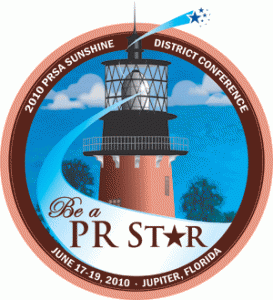
Pack your business cards and bathing suits and get ready to Be a PR Star!
The 2010 Sunshine District Conference is just around the corner. Register Today!!
Conference attendees will learn today’s premier communications techniques from leaders in the profession while getting a taste of the Palm Beach’s rich history and culture. Workshops will focus on a variety of topics, including advancements in social media, crisis communications, ethics and law, web marketing, and earning your accreditation.
If you want to stroll on the beach while learning the best skills, then Be a PR STAR at the 2010 PRSA Sunshine District Conference.
WHEN: Thursday-Saturday, June 17-19, 2010
WHERE: Right on the beach – at the Jupiter Beach Resort & Spa, Jupiter, Fla.
WHY: Situated along one of the richest coastlines in the country, Jupiter is steep in history from the pirates of the 1700s to the local celebrities who call it their home. You’ll be steps away from the shoreline and the treasures of the ocean while learning from nationally-renown speakers and experts in the profession.
Attendees: The PRSA Sunshine District Conference is hosted annually by one of the District’s seven chapters. Though hosted by a PRSA chapter, membership is not required to attend, and in fact, conferences typically include representation from numerous communications groups, including IABC, FPRA, AIGA, and Ad Federations. Approximately 125 to 150 public relations professionals are expected to attend.
Visit http://prsapalmbeach.org/meetinginfo.php?id=5
Posted by Elena del Valle on April 21, 2010
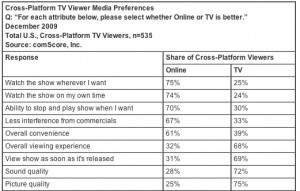
Click on image to enlarge
Photo, chart: comScore
According to a study released last month, people who watch television online are young (54 percent are 35 years old and under), likely to watch programs where and when they choose and more tolerant of ads than regular television viewers. Study participants were asked questions designed to assess their tolerance of advertising (based on one minute increments from 0-15 minutes) when watching one hour of TV programming on the Internet. Analysts determined the highest tolerance for online TV watchers was between six and seven minutes per hour which is much higher than the four minutes per hour of ads delivered online as part of TV content.
Although survey respondents thought sound and picture quality were better on television, most participants in the study, 75 percent, said they choose to watch TV programming online because it is possible to watch it wherever they want (within the United States as many televisions programs are not available online in foreign countries); 74 percent said they do so because they can watch the shows whenever they want; 70 percent preferred watching television programs online because of the stop and play option; and 67 because there is less commercial interference.

Tania Yuki, director, online video and cross-platform product at comScore
“As cross-platform TV viewing becomes more widely adopted, it is important to understand the driving forces behind this shift in consumer behavior if we are to effectively monetize this emerging medium,” said Tania Yuki, comScore director of online video and cross-platform product, in a press release. “While some analysts have suggested that the shift to online video reflects a consumer desire to view fewer ads, our research suggests that in many cases online TV viewers actually have a higher tolerance for advertising messages than they are currently receiving. This finding, of course, suggests there’s advertising revenue being left on the table and that media companies have not yet extracted full value out of the online medium.”
Young TV viewers among the survey respondents said they are most likely to watch television programs at the time of their choosing; only 35 percent of viewers age 18-24 (25-34 year olds behaved similarly) said they watched episodes live; 42 percent said they watched programs at a different time within one week of the original air date and 23 percent said they watched the programs more than one week after the original air date.
Researchers in the comScore study distinguished three segments of television programming viewers. Those who only watched television, TV-only viewers, (65 percent); those that watched television programs on television and online, cross-platform viewers (29 percent); and those who watched televisions programs only online, online-only viewers (6 percent). Study analysts compared the attitude differences between the three groups. The study, based on a survey of more than 1,800 U.S. Internet users who watch originally scripted TV content, was first presented by Tania Yuki at the ARF Re:think conference on March 23, 2010.
According to a comScore spokesperson the study did not include ethnic profiling. However, independent data suggests Hispanics skew young as a demographic group and over index in the use of the internet, making it possible, even likely, the findings of the study apply to Hispanics who watch television programs online.
Posted by Elena del Valle on April 19, 2010

Teresa Iglesias-Solomon, vice president, Multicultural and Latino Initiatives, Best Buy
Photo: Best Buy
A podcast interview with Teresa Iglesias-Solomon, vice president, Multicultural and Latino Initiatives, Best Buy is available in the Podcast Section of Hispanic Marketing & Public Relations, HispanicMPR.com. During the podcast, she discusses issues relating to marketing to Latinos with Elena del Valle, host of the HispanicMPR.com podcast.
Teresa leads strategies relative to serving diverse customers, with an emphasis on Hispanic communities. Her cross-functional team is responsible for gaining deep understanding of different cultures, and translating that insight into respectful and meaningful relationships in the company stores, online and in their communities.
Teresa, a 20-year industry veteran and native Latina who has lived and worked in Mexico and the United States, joined Best Buy in 2007. Prior to working with the national retail company, she led marketing efforts targeted to the U.S. Hispanic market for Domino’s Pizza where she established the company’s first-ever Hispanic Advisory Council and launched a national Hispanic campaign tied to the World Cup. She also has worked for Accu Bite Dental, Kellogg Company and Lever Brothers where she launched the first national campaign for Close-Up toothpaste targeting the Hispanic market in the United States.
Teresa earned her master’s in business administration from Stanford University in 1986. She serves on the board of directors for Amcore Bank, a regional chain with locations in Wisconsin and Illinois; and is a member of Latinos Unidos, a non-profit organization serving the Latino community in Ann Arbor, Michigan.
To listen to the interview, scroll down until you see “Podcast” on the right hand side, then select “HMPR Teresa Iglesias-Solomon” click on the play button below or download the MP3 file to your iPod or MP3 player to listen on the go, in your car or at home. To download it, click on the arrow of the recording you wish to copy and save it to disk. The podcast will remain listed in the April 2010 section of the podcast archive.
Posted by Elena del Valle on April 16, 2010
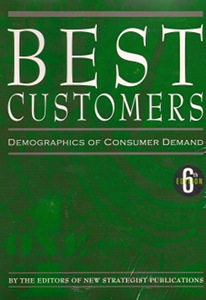
Best Customers: Demographics of Consumer Demand
Did you know that on average Asian households in America spend more than non Hispanic white households? And that black and Hispanic households spend less? At the same time, there are wide variations in some spending habits by ethnic groups. For example, Asian households spend very little on pets while blacks and Hispanics spend significantly more than other groups for children’s clothes.
Marketers wanting to prepare for trends such as the Baby Boomer generation and the rise of ethnic emerging markets like the Asian, black and Hispanic segments, which are estimated to account for one of every five dollars of purchases in America, may be interested in the detailed information about the products and services consumers bought in past years outlined in Best Customers: Demographics of Consumer Demand (New Strategist Publications, $89.95).
The 775-page softcover book breaks down purchases and spending patterns by the demographic characteristics of households based on data from the Bureau of Labor Statistics’ 2007 Consumer Expenditure Survey. The source of the previously unpublished data is surveys of household spending. The time lag between the data collection and the publication of the book, 2009, is about two years.
The book is divided into 21 chapters (in alphabetical order): Alcohol, Apparel, Computers, Education, Entertainment, Financial Products and Services, Furnishings and Equipment, Gifts for People in Other Households, Groceries, Health Care, Reading Material, Restaurants and Carry-Outs, Shelter, Telephone, Tobacco Products, Transportation, Travel and Utilities; and four appendices: About the Consumer Expenditure Survey; Percent Reporting Expenditure and Amount Spent, Average Quarter 2007; Spending by Product and Service, Ranked by Amount Spent, 2007; and Annual Average Household Spending, 2000 and 2007.
The information in the book was originally gathered by the Census Bureau to allow the federal government to track prices. Two groups of 7,000 households (technically called consumer units) each in 91 areas of the country provide the data through two different surveys which are thought to cover 95 percent of expenditures. It is not clear if undocumented residents are included in the survey. Other sources of similar data collection indicate the Consumer Report Survey data is lower than actual except for: rent, fuel, telephone service, furniture, transportation and personal care services.
New Strategist Publications publishes other demographic data titles about consumers (see Book outlines spending by race, ethnic group and New York publisher shares household spending summary) and Hispanics (see Data rich book outlines Hispanic market profile).

Click here to buy Best Customers
Comments:
Filed Under: Books
Posted by Elena del Valle on April 15, 2010
Information provided by our Event Partner

Search Engine Strategies Toronto Conference & Expo – June 9-11
From social media to local search to video optimization, Search Engine Strategies Toronto puts you in front of the experts who will help you sort which technologies and channels will take you to the next level and which are just hype. Deep dive into emerging trends which will shape 2010 and beyond.
Search can put you in control with more measurable results, targeted reach, and constant visibility than traditional marketing. So start making decisions based on the facts and learn how to increase conversions with consistent returns. Register by May 21 and SAVE up to $200 on a platinum pass. Enter 20SMC to SAVE an additional 15% off the current rate.
Sessions include:
- Video: The Next Marketing Frontier
- Augmented Reality: A New World Order
- 21 Secrets of Top Converting Websites
- Integrating Social Media & Search to Drive Brand
- Canada-Specific SEO & PPC Issues
Keynotes
Peter Morville, President, Semantic Studios
Maile Ohye, Senior Developer Programs Engineer, Google
Visit http://www.searchenginestrategies.com/toronto/?code=15mpr&utm_source=hispanicmpr
Posted by Elena del Valle on April 14, 2010
By Marcelino Miyares, Jr.
Director, Mercury Media en español

Marcelino Miyares Jr., director, Mercury Media en español
Photo: Mercury Media en español
A bottom line is a bottom line no matter what we call it. That is why I am a convert to the strategic importance of Hispanic Direct Response TV (DRTV). Taking a DRTV approach to the Hispanic market is a proven and valid model for Hispanic marketing because it focuses attention on the bottom line, not just the investment.
The Hispanic segment has reached critical mass as a demographic and few argue its potential contribution to virtually any brand’s performance in the general marketplace. Thanks to Hispanic DRTV, this is now measurable; and more to the point, allows marketers to forecast and optimize the ROI of a Spanish-language media budget.
Click here to read the complete article Hispanic Direct Response TV Apples are Manzanas
Posted by Elena del Valle on April 13, 2010
Information provided by our Event Partner
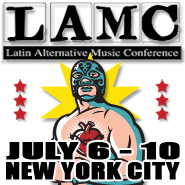
The 11th Annual LAMC (Latin Alternative Music Conference) returns to New York City on July 6 – 10, 2010. LAMC features panels and exhibitions, concerts, parties and art highlighting the best of Latin Alternative music and culture. LAMC is the only major conference geared toward the marketing of Spanish-language alternative music – the voice of today’s Latinos. This five-day event providing networking opportunities with the genre’s leading artists, label executives, journalists, managers, retailers and programmers, is the most extensive gathering of Latinos in entertainment to be offered by a music conference to date.
Latin Alternative Music Conference
Posted by Elena del Valle on April 12, 2010

DeeGee album cover
Photos, song:DeeGeeWorks
Chester (Wilfredo Martes), LuLu (Lourdes Santiago), Papito (Juan Morales) and DeeGee (Miguel Bonilla) known collectively as DeeGee will release DeeGee, their first independent urban Latin music album next month. The first single from the album, Cavernicolas, is being played in radio stations in the United States, Costa Rica, Argentina, Colombia, Spain, Israel, Mexico, Puerto Rico, and the United Kingdom. Scroll down to listen to Cavernicolas.
Martes, a rapper, is originally from the Domincan Republic. Morales, a native of Brooklyn of Puerto Rican descent, has experience as a tropical music singer in the studio and stage. Santiago, from Puerto Rico, is a vocalist and song writer.

DeeGee (Miguel Bonilla)
Bonilla, originally from Colombia, plays piano and drums, produces, arranges, and handles synth programming for DeeGee. He studied at the Juilliard and Manhattan schools of music. According to promotional materials, in 1990, Bonilla joined the Tito Nieves Orchestra and traveled extensively. Later he was piano player for Marc Anthony’s Band for two years before working with La India. Prior to launching DeeGee’s first album he worked in music production.
Click on the play button to listen to Cavernicolas from the DeeGee album
Posted by Elena del Valle on April 9, 2010

Mexican Migration and the U.S. Economic Crisis
In the past couple of years, traffic of undocumented immigrants across the Mexico United States border has declined (see Fewer Mexican immigrants arriving, similar number returning home). Thirty-five researchers participating in the Mexican Migration Field Research and Training Program (MMFRP) based in the Center for Comparative Immigration Studies at the University of California, San Diego, and in partnership with Mexican institutions, contributed a summary of their findings on recent migration from Mexico to the United States. Their work, edited by Wayne A. Cornelius, David Fitzgerald, Pedro Lewin Fischer and Leah Muse-Orlinoff, was published this year as a book titled Mexican Migration and the U.S. Economic Crisis A Transnational Perspective (Center for Comparative Immigration Studies, $29.50).
The researchers set out to better understand how economic shocks affect populations movements, specifically those across the Mexico to United States border. They were curious to know how people were managing in places that provided or received immigrants; how individuals were making decision about migrating, staying at home or staying in the United States; and the importance of U.S. immigration enforcement at the border and within the United States in discouraging immigration and encouraging the settling of immigrants in the United States.
The 269-page softcover book is divided into 10 chapters: Introduction; Coping with La Crisis; Double Jeopardy: How U.S. Enforcement Policies Shape Tunkaseño Migration; Economic Crisis vs. Border Enforcement: What Matters Most to Prospective Migrants?; Inhabiting Two Worlds: Tunkaseños in the Transnational Labor Market; Leaving to Learn or Learning to Leave: Education in Tunkás; Values in Conflict: Youth in A Culture of Migration; The Family Dynamics of Tunkaseño Migration; Sweet Dreams and Bitter Realities: Nutrition and Health Care in Tunkás and the United States; and Reshaping Community Participation: Tunkaseños in a Binational Context.
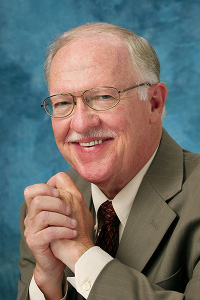
Wayne A. Cornelius, director emeritus, Center for Comparative Immigration Studies (CCIS)
Cornelius is director emeritus, Center for Comparative Immigration Studies (CCIS), University of California-San Diego as well as Distinguished Professor of Political Science. Fitzgerald, associated director, CCIS is author of A Nation of Emigrants: How Mexico Manages Its Migration. Lewin Fischer is senior researcher at the Instituto Nacional de Antropologia e Historia’s Centro Yucatán. Leah Muse-Orlinoff is a Ph.D. candidate in sociology at the University of California, San Diego.

Click here to buy Mexican Migration and the U.S. Economic Crisis
Comments:
Filed Under: Books
Posted by Elena del Valle on April 7, 2010
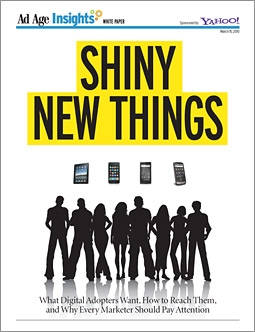
Photo: AdAge
For six weeks Laura Rich researched early adopters of digital technology focusing on their use and purchase of mobile devices, software, computers and televisions. She believes they play a pivotal role for companies introducing new products into the marketplace and highlights that this group of white men, mostly, “can be identified by what they do, not who they are.” Although she identified studies that indicate Latinos often take advantage of digital technologies at rates higher than the general market; what matters more than their race and gender and where they work (often technology companies), she points out in a white paper, is their use of information, and the way they buy products and share their opinions with like minded others.
These opinions can affect the acceptance or rejection of a new product into the market. Aware that their opinions matter these first users of technology products want to be heard by marketers and product makers, she says. Win their favor and you gain an advantage; risk their displeasure and prepare for the consequences, she points out illustrating with examples from well known companies such as Apple, Google, and AT&T.
The staff writer at AdAge shared her findings in Shiny New Things: What Digital Adopters Want, How to Reach Them, and Why Every Marketer Should Pay Attention, a white paper about what would be “most relevant to marketers wanting to reach this crowd.” She concluded early adopters are “opinion leaders” who play a key role in marketing. They are highly educated, have a higher social status and earn higher incomes than traditional consumers. They are often risk takers with high standards for products and companies and are more critical than regular consumers. Many are status seekers who value information more than most other consumers.
Based on her research, she concluded that thanks to the boom in social media, early adopters have a high potential to influence products, especially gadgets and online brands, she describes as “screen power.” Their influence is, she believes, is becoming evident in mega social media sites such as Twitter and Facebook.
According to her findings, 62 percent of early adopters will consider upgrading their mobile phone when a new model is released; 68 percent may have purchased three or more computers in the past two years; and 58 percent are more likely to have purchased three or more flat-screen TV’s in the past two years.
In the white paper, she quoted findings from Pew Internet and American Life and Yahoo! studies that outline digital technology use by ethnic groups. A Yahoo! study indicates Hispanics over index in their adoption of technology and media consumption compared to the general population.
A study by Yahoo!, Telemundo and Experian Simmons Research, she mentions, indicates more than two thirds of respondents had been online for more than five years; 90 percent have a cell phone (compared to 79 percent of the general population); 66 like to send text messages (compared to 38 percent of the general population; although only 61 percent had taken photos with a cell phone (compared to 79 percent of the general population.
























